Beth Kanell's Blog, page 9
April 29, 2022
A Photo of Gracie's Hotel, Lyndonville: As Promised!
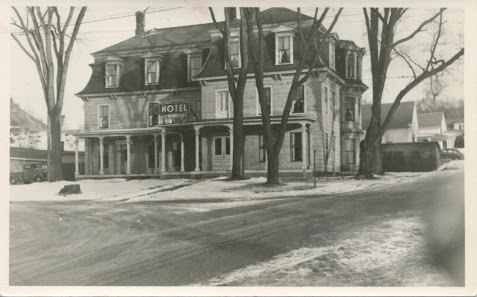
Last month I was honored to present a talk on writing historical fiction for the DKG VT (active and retired teachers), Northeast Kingdom section, meeting in Lyndonville. I promised to try to locate an image of Gracie's Hotel for one of the people at the meeting.
And here it is! By way of explanation, here's what my husband Dave (the true Lyndon expert in the family) wrote about it, on April 11, 2018:
Looking Around Lyndonville, Vermont Today: Postcard circa 1950?. The sign on the building says "HOTEL LYNDONVILLE"To the left of the building and over the door way is another sign that says "RESTAURANT" At this point of time the hotel was owned and managed by Nap. G. Clements who was from Montreal. ( I wonder if the NAP was shortened for the name Napoleon.) The second image is an advertisement from the 1957 edition of the Vermont Year Book/Walton's Register.The hotel had 30 bedrooms. The Sportman's Room and The Casbah Lounge (A Replica of an Egyptian Tent)The Hotel advertised in the Lyndon Teachers Yearbooks in 1953, 1954 and 1958.Over the years the Hotel had many names: *The Pleasant View House * Centennial House * Union House * Chase's Hotel, * and Gracie's Inn. On line someone wrote that the Hotel burned to the ground on June 3, 1969 and another person gave the year the Hotel burned down as 1967.This is a winter scene. The hotel was located in the vicinity of where the Union Bank now stands.DKG folks, please do pass the word on this! Doing author talks often opens up fresh historical research for me. Glad we can all share this.
April 20, 2022
Like Oil and Water
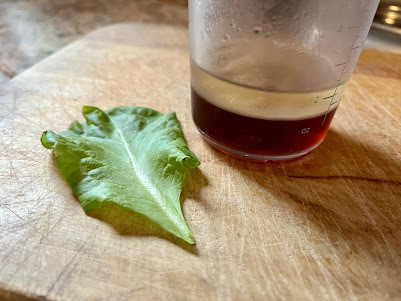
My brother, doing his best to reassure me, said,
“Have faith in God. It will all work out.” And I told him
(because I’ve been raw as a scrubbed potato
since Dave died) “I do, I do have faith! I know
G-d will come through. But I’ve been to the river
more than once. Not my first rodeo, or my first hour
on my knees in spite of their arthritis. So Tom, listen—
sometimes G-d answers ‘no way’ and I don’t yet have
my answer on this one. And I get scared.”
It’s like oil and water, this graced mix of faith
and long experience. Now that I’m almost seventy
(this magical age) I’ve seen it over and over,
settling, separating, a classic vinaigrette:
Keep your wrist strong. Keep shaking the bottle.
-- BK
@font-face {font-family:"Cambria Math"; panose-1:2 4 5 3 5 4 6 3 2 4; mso-font-charset:0; mso-generic-font-family:roman; mso-font-pitch:variable; mso-font-signature:-536869121 1107305727 33554432 0 415 0;}@font-face {font-family:Calibri; panose-1:2 15 5 2 2 2 4 3 2 4; mso-font-charset:0; mso-generic-font-family:swiss; mso-font-pitch:variable; mso-font-signature:-536859905 -1073732485 9 0 511 0;}p.MsoNormal, li.MsoNormal, div.MsoNormal {mso-style-unhide:no; mso-style-qformat:yes; mso-style-parent:""; margin:0in; mso-pagination:widow-orphan; font-size:12.0pt; font-family:"Calibri",sans-serif; mso-ascii-font-family:Calibri; mso-ascii-theme-font:minor-latin; mso-fareast-font-family:Calibri; mso-fareast-theme-font:minor-latin; mso-hansi-font-family:Calibri; mso-hansi-theme-font:minor-latin; mso-bidi-font-family:"Times New Roman"; mso-bidi-theme-font:minor-bidi;}.MsoChpDefault {mso-style-type:export-only; mso-default-props:yes; font-family:"Calibri",sans-serif; mso-ascii-font-family:Calibri; mso-ascii-theme-font:minor-latin; mso-fareast-font-family:Calibri; mso-fareast-theme-font:minor-latin; mso-hansi-font-family:Calibri; mso-hansi-theme-font:minor-latin; mso-bidi-font-family:"Times New Roman"; mso-bidi-theme-font:minor-bidi;}div.WordSection1 {page:WordSection1;}
March 7, 2022
Passumpsic Photos Lasting a Century—and More (Ernest Skinner)
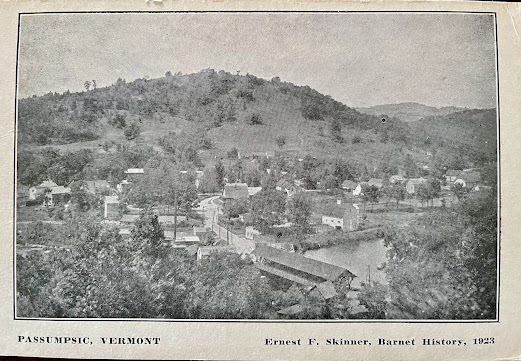
The other day I pulled out a cardboard folder labeled "SKINNER Postcards Passumpsic," to delve into the images DK* collected that were photographed by Ernest F. Skinner, a farmer who lived a few miles south of St. Johnsbury in the Barnet village of Passumpsic.
DK provided several notes on the most formal image—one that was clearly marketed as a postcard, with a line down the center of its reverse, and the two sides of the line labeled "This Space for Correspondence" and "This Space for Address." The photo on the front is helpfully labeled "Passumpsic, Vermont" and "Ernest F. Skinner, Barnet History, 1923." That snippet that says "Barnet History" indicates Mr. Skinner provided his photo to Frederick Palmer Wells for use in the massive volume of town history.
The covered bridge is obvious in the photo, along with the prosperity of this little village at the time. DK noted that Ernest F. Skinner (1885-1978) was a farmer in Passumpsic and had become a naturalized citizen of the United States in March 1922. His wife was Nellie M. Skinner, 1866-1965.
There are many postcard-size images today that indicate that Vermonters in the 1920s, and probably for a decade before that, enjoyed having their portraits or home portraits turned into cards that they could mail at low cost. Mr. Skinner clearly expected the photos he prepared of his village and adjacent East Barnet to be shared. It's likely that local shops sold them.
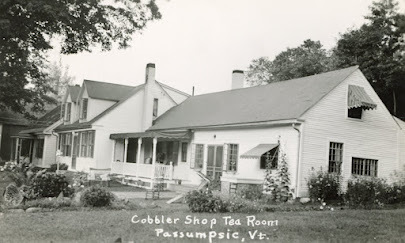
This image is labeled "Cobbler Shop Tea Room Passumpsic, Vt." and I remember when DK and I were tracking it down. He dates the card to 1920 with a mention of "4 Squares." His notes add that the house, owned in 2018 by Jeremy and Roxanne Roberts, is next to the one then owned by Craig Beck.
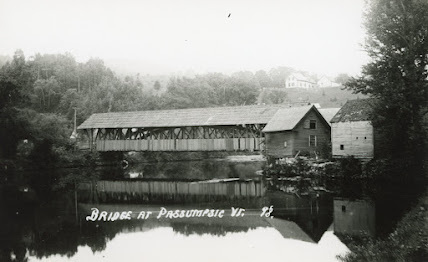 There are two copies of the next image, differing a bit in how dark they are. I like the evidence of local historians collaborating, since DK's first note attached says "Paul Chouinard says this in an Ernest F. Skinner Photo." It shows the wooden covered bridge in Passumpsic, built in 1898. The bridge was destroyed by the Great Flood of Nov. 3-4, 1927, and DK notes there were 1285 bridges lost in that flood. "Looking South, Passumpsic River Bridge 1898, Passumpsic, Vermont. Looking closely at the farm house on the top of Mill Hill. In 2000 the house and large barn were still present. (Info Bruce Filgate)" says DK's added note, crediting another local historian.
There are two copies of the next image, differing a bit in how dark they are. I like the evidence of local historians collaborating, since DK's first note attached says "Paul Chouinard says this in an Ernest F. Skinner Photo." It shows the wooden covered bridge in Passumpsic, built in 1898. The bridge was destroyed by the Great Flood of Nov. 3-4, 1927, and DK notes there were 1285 bridges lost in that flood. "Looking South, Passumpsic River Bridge 1898, Passumpsic, Vermont. Looking closely at the farm house on the top of Mill Hill. In 2000 the house and large barn were still present. (Info Bruce Filgate)" says DK's added note, crediting another local historian.
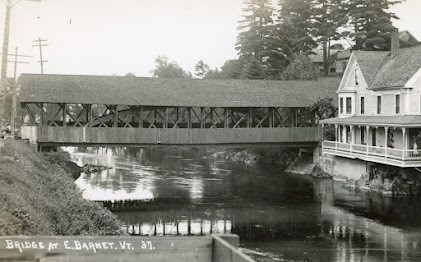
Among the notes connected with this Skinner photo of the East Barnet covered bridge is a printed scrap without the source: "This is a photograph of the East Barnet covered bridge over the Passumpsic river which was taken out by the flood of 1927. Note the elevation of the bridge over the river which provides a reference point regarding the height of the raging flood waters during the flood of 1927. It started raining on the evening of November 2, 1927 and by the time the rain ended on November 4th, nine inches of rain had fallen in a 36 hour period. The ground was already saturated from heavy rains during the month of October and was not capable of absorbing mo[r]e moisture. The damage from flooding was devastating to all of the towns and villages located along the Passumpsic river."
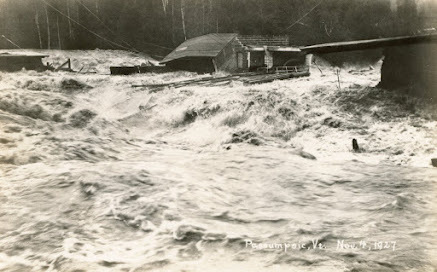
This next Skinner image is of those flood waters. The photographer's caption reads "Passumpsic Vt. Nov. 4, 1927" and DK notes that the image is included in the book "Lights and Shadows" on page 56, labeled "The Uncontrolled Flood Waters at Passumpsic."
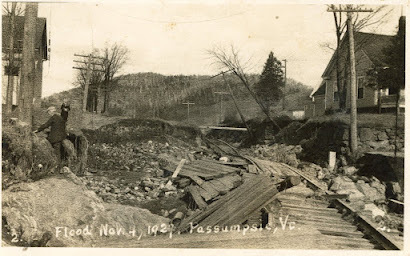
The flood did more than tear out the bridge—it also wrecked the train station and rail lines. Mr. Skinner's photo postcard is marked "Flood Nov. 4, 1927, Passumpsic, Vt." I wonder how the milk was moved, while both the river and the rail were impasssible.
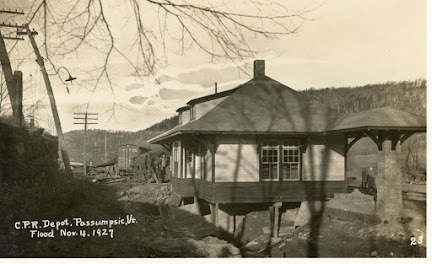
For another perspective on the damage, here is the depot itself; look closely to see the footings washed away. Mr. Skinner's label is "C.P.R. [Canadian Pacific Railway] Depot, Passumpsic Vt. Flood Nov. 4, 1927."
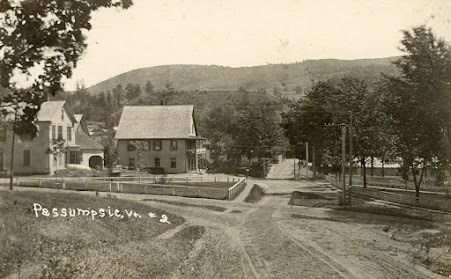
This very full image is marked "Passumpsic, Vt. #2" by the photographer. DK's note reminds us that it shows the village corner on Route 5. He describes the card as a Velox (an image created by adding a screen to a photo), dating it to 1907-1914. Paul Chouinard has written about the store at this corner and the nearby residents, from his experience growing up in the village in the 1950s.
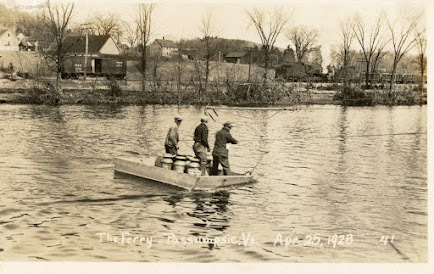
Inspect "The Ferry Passumpsic Vt. Apr. 25, 1928 (card number) 41" and see the 10-gallon milk cans crossing the river; the ferry operator is using a cable to pull the flat-bottom vessel along. DK points out the engine and railroad freight cars in the card also, and commented that the ferry is "listing or tilting." The milk cans prompted him to add notes on the Passumpsic Creamery, operated by the Passumpsic Creamery Association, M. K. Bruce, Mgr; operations were 1879-1964. A second note mentions Mountain View Creamery in the area's 1930 directory, with J. J. Richie Mgr.; O. [Ollie] B. Exley was the foreman in West Barnet [his daughter was teacher Miss Karlene Exley—BK].
I'm glad to have taken time to type up DK's notes and present these cards. I anticipate more Passumpsic Village history from Paul Chouinard in the future.
*DK is my late husband David Kanell -- as he would ink in, 1952-2019.
February 19, 2022
Telling the Story: "Narrative Therapy," the Arc of Narrative, and Long Grief
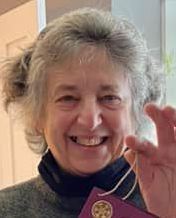
[Not a riddle.] How do you know when your relationship really, really matters?
[Answer.] You'll know after it's over.
Telling the story of a partner's death is a necessity for a while. For me, it helped make sense of the drastic changes in my life, the rainstorm of sorrow, and the questions that pop up. Like, did I do everything I could? From the person that I am, that is?
A year and a half after Dave's death, which was expected but no less tragic, I found myself stuck on a very big decision that only I could make. Sell the big wonderful house where we'd spent most of our married time, in order to move into something small and more affordable? Or do everything else possible to hold onto it, from renting out the garage to hosting an air b'n'b to endless garage sales and round-the-clock work schedules?
Each option involved pain. Neither guaranteed relief from grieving, either.
When I realized I was "deciding" twice a day, frantically flipping from one choice to another -- and I am a person who usually has no problem making decisions -- I searched online for a counselor who could pitch in. It was the first autumn of Covid, which for me yielded a very specific blessing: therapy via Zoom meetings. No commute time wasted, no problems with road conditions, and no need to leave the house empty, either. (I was starting to feel as worried about any time away from the house, as I had felt about time away from Dave as his health slid, and slid, and slid. I didn't want him to face fear alone. And I didn't want the house to be damaged by any absence.)
My life is framed in stories: written, told, present, past, truth and decorative. To my utter astonishment and amusement, the counselor prescribed "narrative therapy." I'd never heard of it but it seemed "genius" for a novelist ... When I looked it up, here's what I found:
Narrative therapy is a style of therapy that helps people become—and embrace being—an expert in their own lives. In narrative therapy, there is an emphasis on the stories that you develop and carry with you through your life. (Jodi Clarke, MA, LPC/MHSP)It Worked Within a month I'd reached a decision I could live with (sell the house, tackle the huge challenge of taming an abandoned piece of land nearby, create a new home). I knew a lot more, too, about what factors in my life were driving my decisions, and which ones were constantly causing me pain. I discovered that I could stop pressing down hard on the inevitable wound of grief and loss, and breathe a bit better as a result.
Because stories ARE my life, eventually I started to play with the narrative arc -- oh, if that's not a familiar term, check out the MasterClass article on these. Here are the parts of the narrative arc that the the article describes: Exposition: The reader’s introduction to the story, providing background information to prime the audience. Rising action. This usually begins with a triggering event that puts the story in motion.
Climax.The highest point of tension in the storyline, often forcing the main character to face a truth or make a huge decision. Falling action. The conflict gives way toward resolution. Resolution. This is not always happy, but shows how the events of the story have changed the characters and the world around them.
How could I fit that idea to the stage of my life opening up -- that is, surviving without Dave? If my decision to let go of the house was stage 3 of the narrative arc, was everything after this "falling action"? Just aging in place, alone? Look out, I could weep over that, pretty easily.
Even worse, maybe I was in the resolution part. What a terrible thought! All the good parts of the story were done, and I could "look forward" to simmering grief in solitude, with nothing much changing again, because the changes were done.
Another Approach
Although I'm not "seeing" the counselor as often, I rely on her backup. And in this case, she reminded me about something we'd outlined together, a year ago. Brace for it: I have a team. And on my team (I may have foreshadowed that I'm a nerd, didn't I? in some ways??) are the books and characters that I embrace. Sometimes that's George Smiley; sometimes Rivers in the Regeneration Trilogy; sometimes Katniss, or even (and in another medium) Phryne Fisher. There are more.
A few weeks ago, the counselor reminded me to lean on my team.
So I opened a few books in a row, and found one divided into PARTS. Three of them. Each part had its own arc of narrative. And none of them functioned without the others.
This is what I've chosen for my narrative today:
Part I: Life before meeting Dave. Adventurous but with some serious lacks.
Part II: Life with Dave. Not always easy, including his illness, but omigosh varieties of fun and a resolution that let me see how much I changed, how much his life reshaped mine and strengthened me.
Part III: Life with Dave out of reach. He'll never stop being present as a force in the next part of the character arc. (And missing him won't end.) But there are chapters ahead, and I am not at "the end."
As the expression goes, "That's my story." For today.
February 14, 2022
When Love Overflows in the Northeast Kingdom
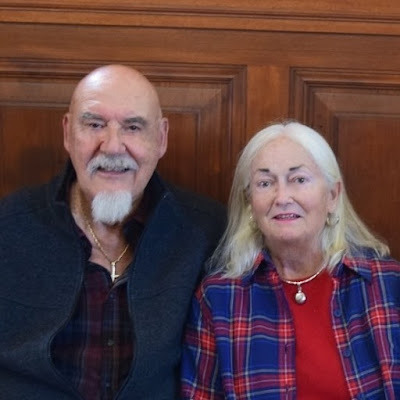 Paul and Bernadette Berthiaume Chouinard
Paul and Bernadette Berthiaume ChouinardLook at the greatest love stories that your English teacher pointed to: Romeo and Juliet. Casablanca. Wuthering Heights. If you are hearing a bit of sad music as you reflect on these, you're not alone.
True love, in real life, however, rarely steps onto the stage or the movie screen. It persists through challenges, and it overflows in ways that brighten and enrich the lives around it.
A ready example of how this works: Bernadette and Paul Chouinard, of Vermont's Northeast Kingdom.
 Duchess, Paul, Duke.
Duchess, Paul, Duke.This gracious couple celebrated 51 years of marriage this week. In addition to parenting and grandparenting with determination and grace, they continue to add to the richness of life in this region. Bernadette posts Facebook images of artfully plated meals she prepares, with the clear intent of nourishing both spirit and body. Paul retrieves images of the region's history and posts them in several Facebook forums that celebrate growing up here and the strong and creative people who've shaped the Kingdom. He annotates them with history from his own research, as well as a wider scope from his career as a teaching historian.
Retirement is a fullness for this couple, rather than an emptying. Each day, they promote beauty and the ability to treasure what others have built, whether in the momentary beauty of a flower or the enduring resonance of architecture and photographed celebrations.
Paul and Bernadette treasure their Shih Tzu dogs, who are their babies now, curling on their laps, trotting around the lakeside home, and riding carefully along on automobile excursions. "Duke" and "Duchess" enjoyed a loving relationship with each other, as well as with their people.
So it was a terrible, heart-breaking shock when Duchess abruptly died on February 9. Nothing had prepared the Chouinards for such a drastic change. Most of all, they worried about Duke — how could he understand and how would he adapt to the absence of his small, sturdy companion?
There seemed no time to lose in finding a comfort for Duke. And when Paul asked online for word of another Shih Tzu to enter their home, blessings in the form of people who love pets came forward right away -- the next day, young Scarlet entered the family. As Paul explained, "She is not a replacement for Duchess, who will always be in our hearts. She will help to heal our pain and to reduce Duke’s anxiety."
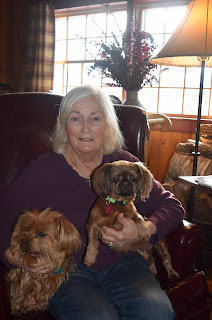 Duke, Bernadette, Scarlett
Duke, Bernadette, Scarlett
Small reports of the interactions of the two dogs -- who wagged a tail, who ate or refused to eat, who slept or could not sleep -- followed. And on the second day of Scarlet's presence, this report came:
"Duke seems to have experienced a day of mixed emotions. There are times when it is clear that he is looking for Duchess and feels confused by her absence. He did not eat this morning and was lethargic for a large part of the day. He and Scarlet have done well in adjusting to one another. They are respectful of one another and they are good about sharing their time and attention with each of us. We have been very aware of Duke's emotional struggle and we have given him lots of love."
The two little dogs were there as Bernadette and Paul marked 51 years of marriage on Sunday. Their most recent year held health challenges for both adults, as well as the tragedy of Duchess's passing. As Paul reflected on 51 years ago, he wrote, "We were married at the Church of the Nativity in Swanton, Vt, by Bernadette's cousin, Father Spear. It was a memorable event for many reasons. Our wedding took place in the midst of a major ice storm. We survived that challenge and many others related to our wedding and emerged as a married couple. Bernadette has been a major blessing in my life and in the life of our family. This past year, given the incredible health challenges that I faced, I would not have survived without her loving care. She has been a wonderful wife, mother, teacher, daughter and friend to all who are fortunate to know her. This week has been a particularly challenging week for both of us with the loss of our beloved Duchess and the adjustment for Duke with the acquisition of our new baby, Scarlet. Once again, we are weathering the 'storm.' I feel confident that with Bernadette's love and support we will emerge from it."
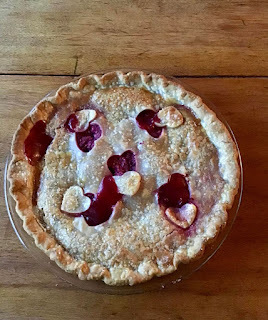
Bernadette marked the weekend of long-term romance — from wedding to mutual support to today's Valentine celebration — with a love-themed raspberry pie for Sunday's dinner.
As we who receive the daily Facebook photos and writings from the Chouinards continue to marvel at the beauty they infuse into their lives and those of the "babies" in their laps, I'm reminded of a "proverb" from the great writer William Blake: "The cistern contains; the fountain overflows."
Clearly, the Chouinards continue to craft a fountain of love. May this next year be an easier one, with many friends to appreciate the love they share.
 R.I.P., Duchess -- well loved.
R.I.P., Duchess -- well loved.December 31, 2021
Just a Little Further: Writing the Novel and Learning the Horse and Buggy
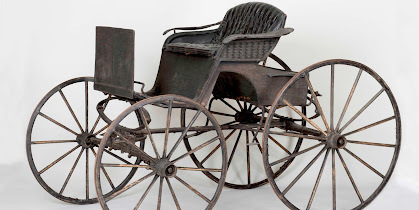 In the collection of the Shelburne Museum. No brake!
In the collection of the Shelburne Museum. No brake!Within the next week or so, I expect to finish writing the third book in my Winds of Freedom series. It's set in Vermont in 1854, and it's had a working title of Kindred Hearts, but I'm quite sure that will change. I'm waiting until the last plot twist, passion for the future, and page of dialogue are done. Then I'll brainstorm titles.
Meanwhile, I've been working hard at learning how to hitch a horse to a buggy and drive it! Somehow this was not mentioned in any of my history courses. Luckily, although Vermont winter isn't exactly conducive to asking a neighbor to show me the reins, there are many engrossing YouTube videos that show how to put on a harness, how to attach the "hames," and much more.
Then I've also been taking a crash course (self-taught) in buggies themselves. My protagonists, Almyra and Susannah, are fortunate to have access to the resources of a small livery stable at their village inn. That means that sometimes they don't have the kind of buggy or carriage they want -- and sometimes they end up on horseback themselves. Learning about riding with a sidesaddle was another treat of this book!
Here are some of the images I've studied, working out who puts her foot where, how much risk there is that she'll show a shocking amount of her ankle or petticoat, and more.
Thanks in advance to Fran and Bert Fissette, neighbors who've loved their horses and have answered some of my questions via text, so I could keep typing!
Circ1 1915:
Late 1850s:
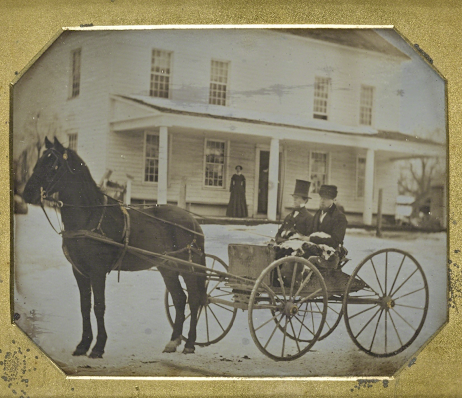
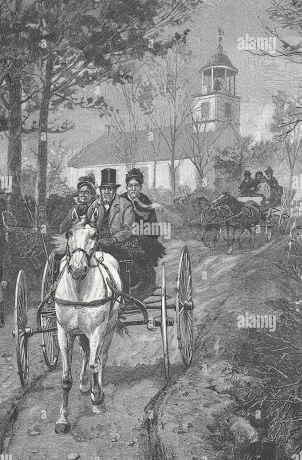

October 10, 2021
Cotton Mather: From Salem Witch Trial Disaster to Hybrid Corn Experiments to Immense Loss
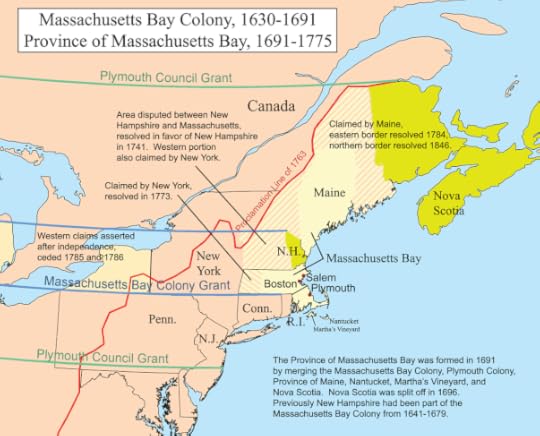 Check out these early provincial boundaries, via a Creative Commons map created by Kmusser.
Check out these early provincial boundaries, via a Creative Commons map created by Kmusser.I'm about halfway through writing KINDRED HEARTS, and every surface around me is covered with research. Not very tidy, but how exhilarating!
At this stage, also, almost everything around me spurs fresh inquiry ...
Neighbors up the road just took their daughters to visit Salem, Massachusetts, and that sent me to reviewing the Salem Witch Trials and the notorious role of Cotton Mather (1663-1728) in them.
In turn, that sent me to Wikipedia for a quick review -- I often find Wikipedia to be a great jumping-off site for research, loaded with footnotes. I don't take the view of the Wiki writer as necessarily "valid" but I find a lot to explore from, after looking at this, from https://en.wikipedia.org/wiki/Cotton_... the last paragraph made me very sad:
Mather was born in Boston, Massachusetts Bay Colony, the son of Maria (née Cotton) and Increase Mather, and grandson of both John Cotton and Richard Mather, all also prominent Puritan ministers. Mather was named after his maternal grandfather John Cotton. He attended Boston Latin School, where his name was posthumously added to its Hall of Fame, and graduated from Harvard in 1678 at age 15. After completing his post-graduate work, he joined his father as assistant pastor of Boston's original North Church (not to be confused with the Anglican/Episcopal Old North Church of Paul Revere fame). In 1685, Mather assumed full responsibilities as pastor of the church.[1]: 8
Mather wrote more than 450 books and pamphlets, and his ubiquitous literary works made him one of the most influential religious leaders in America. He set the moral tone in the colonies and sounded the call for second- and third-generation Puritans, whose parents had left England for the New England colonies, to return to the theological roots of Puritanism. The most important of these was Magnalia Christi Americana (1702) which comprises seven distinct books, many of which depict biographical and historical narratives.[3]
Mather influenced early American science. In 1716, he conducted one of the first recorded experiments with plant hybridization based on his observations of corn varieties. This observation was memorialized in a letter to his friend James Petiver:[4]
First: my Friend planted a Row of Indian corn that was Coloured Red and Blue; the rest of the Field being planted with corn of the yellow, which is the most usual color. To the Windward side, this Red and Blue Row, so infected Three or Four whole Rows, as to communicate the same Colour unto them; and part of ye Fifth and some of ye Sixth. But to the Leeward Side, no less than Seven or Eight Rows, had ye same Colour communicated unto them; and some small Impressions were made on those that were yet further off.[5]
In November 1713, Mather's wife, newborn twins, and two-year-old daughter all succumbed during a measles epidemic.[6] He was twice widowed, and only two of his 15 children survived him; he died on the day after his 65th birthday and was buried on Copp's Hill, near Old North Church.[1]: 40
October 8, 2021
Postcard Insights: Autumn in Vermont, via the Lens of Alois Mayer

This isn't a great day for me to make a road trip for foliage photos, but my late husband Dave's postcard collection can always fill in! Here, at the top, is a view of Jay Peak taken from a field of grazing cows in Newport (Vt.). Continuing the dairy theme, the middle card is an aerial view of Cabot, home of Cabot Creamery, surrounded by farms. The third (bottom) card shows Lake Memphremagog, looking from the north toward distant Willoughby Gap. The photos are probably from the 1980s, says Dave's note.
What intrigued me today is that all three cards feature photos by the same person: Alois Mayer. So of course I looked up the name, and found this in the Valley News from March 8, 2021:
BOMOSEEN, VT — Alois Mayer was born on March 23rd, 1938 and died on February 26th, 2021. He was raised in Maria Alm, Austria. Alois was the eighth of ten children of Sebastian and Katharina Mayer. As a young man, Alois was a ski instructor in Austria which led to his coming to America in 1963 at the age of 25 to work at Killington Mountain and eventually as the Ski School Director at Pico Peak for several years. Alois then focused his efforts into his considerable talent as a landscape photographer, selling his postcards and calendars across the State of Vermont for decades, through the business he founded Mayer Photo-Graphics, until his retirement.
Alois is survived by his two sons Jon and Kristian, his four grandchildren, his brothers Balthasar and Alexander, and his sister Susanne.
How remarkable! "Every picture tells a story" -- and this group of foliage photos led me to a very unexpected one. My sympathies to the family of this photographer, who has clearly made his mark in Vermont in at least two significant ways.
October 2, 2021
From the Earth Itself: Pottery Made in St. Johnsbury Center
Every time I pass a brick house in the Northeast Kingdom of Vermont, I'm reminded that these long-lasting house components came directly from the soil here. My understanding is that brickyards were once common in the region, especially along the streams and rivers, where clay beds could be found.
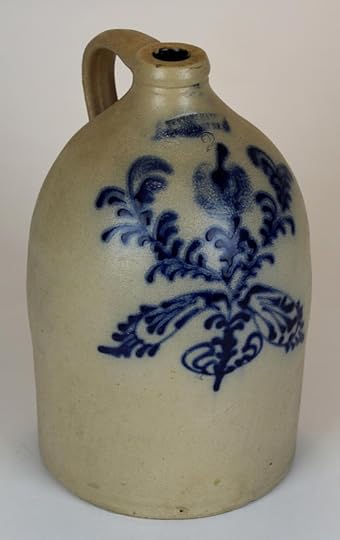
But it wasn't only bricks that came from such clay. Pottery, a classic of early American life, is formed from this specially elastic material, which can be shaped and then baked at high temperature in a kiln, to form waterproof containers. According to St. Johnsbury historian Edward Fairbanks, the products of the St. Johnsbury Stone Ware Pottery "were in constant demand until the introduction of tinware."
Studying the history of the Center Village, known today as St. Johnsbury Center, took me seeking the history of this pottery. "Early New England Potters and Their Wares" by Lura Woodside Watkins fills in the details that Fairbanks mentions in his history.
General (probably a militia title, perhaps from our Revolution) Richard Webber Fenton founded his stoneware manufactory about half a mile south of the village, on the west side of the river. His son Leander W. Fenton seems to have taken on the business and partnered with someone named Hancock; the "domestic ware" ("from jugs, jars, bottles and milk pans, at a dollar a dozen, to fancy flower pots at sixty cents each," wrote Fairbanks) were marked either "L. W. Fenton" or "Fenton & Hancock," along with the town's name. Power for the pottery, with its spinning potters' wheels, came from a brook spilling down the slope.
Watkins wrote that a great-granddaughter of Leander's, Mrs. W. W. Husband, lived in St. Johnsbury and had a list of the articles available in the late 1850s:
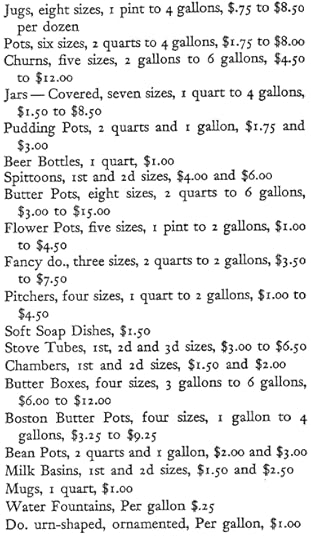
Both Fairbanks and Watkins mention the end of the pottery firm in November 1859, when a fire destroyed it. While working on my recent article on St. Johnsbury Center history for the October 2021 North Star Monthly, I found mention of the fire in the Caledonian, reprinted in the November 17, 1859, edition of the Green-Mountain Freeman:
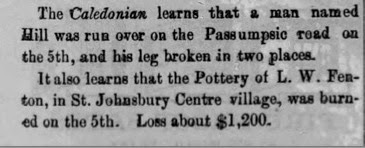
I don't know of any items from this potterymaker locally, although Watkins enthuses about a distinctive one of the water coolers, with cobalt blue decorations that she guesses might have been done by either Eleazar Orcutt or Edward Alonzo Crafts, both known to have been employed in St. Johnsbury.
Jugs with the Fenton & Hancock mark come up at antique auctions fairly often, and I have borrowed an image from one of these to show above. Look closely and you can see part of the name of the pottery across the top of the blue decoration.
August 31, 2021
Hiking Her Way Into a New Biography: Annie Gibavic and the Adventures of Writing

Annie Gibavic, who lives in Sutton, Vermont, says she's always loved to hike. In 2003, Bondcliff Books published her memoir of a 3-week "through hike" of Vermont's Long Trail. Called ALONE BUT NOT LONELY, the book was well received and demonstrated her ways of challenging herself and finding joy.
At that time, a woman hiking alone was still fairly rare; comments on the discussion site GoodReads reflect how the book was valued:
It's been a long time since I last read this book, and when I was a kid it inspired me to want to hike the Long Trail. Before I left for my own hike on the LT this year, I picked it up again to revisit Annie's story. Honestly, her trail journals are just like any other trail journals, but I think when I was younger, it was a lot more unusual to find a woman doing this kind of thing alone. I'm still thankful for how my own hike was sparked by this one book picked up in a thrift store so long ago. Vermont is a magical place, and the LT is a very special trail indeed.
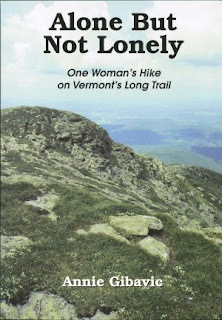 When Annie herself was a teenager, she interacted often with her aging great-aunt Dorothy C. Walter, a woman born in the late Victorian years whose life involved unusual paths for that time. Dorothy not only performed the expected roles of caregiver for several family members -- she also taught "Americanization" to many immigrants in Providence, Rhode Island, and brought back explorations of her adventures there to women's and church groups in Vermont's Northeast Kingdom. For many listeners, Dorothy—an ardent writer herself—may have been the first to explain to her home-grown Yankee audience that immigrants need not be "dirty" or "ignorant" and that their foods, even though seasoned in ways Yankees never indulged, could be delicious. (You can read my recent feature on Dorothy here.)
When Annie herself was a teenager, she interacted often with her aging great-aunt Dorothy C. Walter, a woman born in the late Victorian years whose life involved unusual paths for that time. Dorothy not only performed the expected roles of caregiver for several family members -- she also taught "Americanization" to many immigrants in Providence, Rhode Island, and brought back explorations of her adventures there to women's and church groups in Vermont's Northeast Kingdom. For many listeners, Dorothy—an ardent writer herself—may have been the first to explain to her home-grown Yankee audience that immigrants need not be "dirty" or "ignorant" and that their foods, even though seasoned in ways Yankees never indulged, could be delicious. (You can read my recent feature on Dorothy here.)
Annie's personal memory of Dorothy from her teen years is really a classic of how a not-yet-grown girl sees things: She recalls Dorothy's large size, and the tremendous efforts required to assist her on the narrow staircase of the family home, when the elderly woman broke her hip!
But as an adult, Annie became a teacher herself, and with her mother Annette's edited packets of Dorothy's writing, Annie began to identify more with her great-aunt. At first she taught at an alternative school in Peacham, with a curriculum based on musical theater. "Dance was my first love," she explains, and it led her into work at a choreographer for the Vermont Children's Theater and for a high school. Further, as an art teacher at Miller's Run School in Newark, VT, for 25-30 years, she also taught ESL, or English as a Second Language -- that is, English for immigrants.
And all the while, she hiked, and she re-read the family stories, especially Dorothy's. One day she suddenly realized that "Americanization" and teaching English as a Second Language overlapped substantially. She marveled that she hadn't realized until that moment how closely her life meshed with her great-aunt's adventures.
Over the past few years, Annie's been writing another book. This time, like Dorothy and like Annie's mother Annette, the writing focuses on a relative: Joseph Hall, the "adventurous brother," she says, of her great-great-grandfather Dudley P. Hall. Bondcliff Books, which published her trail book, is considering her manuscript. It would be both history and "family memoir," and pulls her life even closer to Dorothy's.
I met with Annie a few weeks ago to learn about Dorothy -- we sat outside Café Lotti in East Burke, so we could chat without masks. Astonishingly, we were sitting next door to the former home of Joseph Hall.
So how could I resist? When we finished talking about her family and their intriguing history, I asked Annie to step next door so I could take her photo with Joseph Hall's house behind her. I hope her book will be published soon, so I can enjoy this adept writer and hiker's view from the mountains today.



